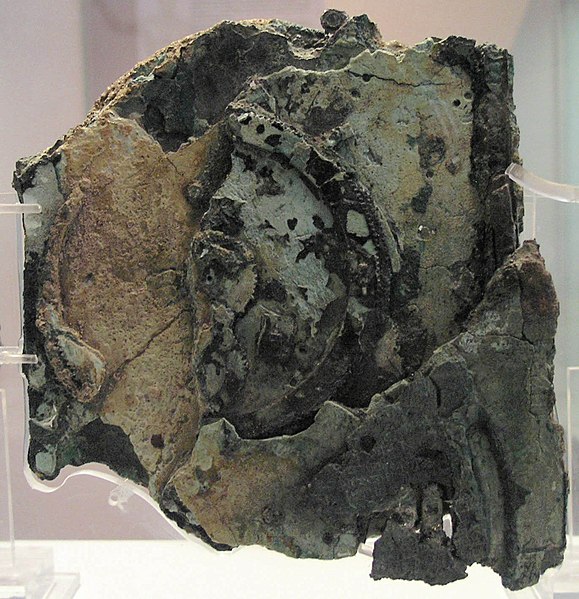NAMA_Machine_d'Anticythère_4.jpg

Summary
| Description NAMA Machine d'Anticythère 4.jpg |
Fragment principal de la machine d'Anticythère. Le mécanisme consiste en un système complexe de 32 roues et plaques portant des inscriptions relatives aux signes du zodiac et aux mois. L'étude des fragments suggère qu'il s'agissait d'une sorte d'astrolabe utilisée pour la navigation maritime. L'interprétation désormais généralement acceptée remonte aux études du professeur Derek de Solla Price, qui fut le premier à suggérer que le mécanisme est une machine à calculer le calendrier solaire et lunaire, c'est-à-dire une machine ingénieuse pour déterminer le temps sur la base des mouvements du soleil et de la lune, leur relation (éclipses) et les mouvements des autres étoiles et des planètes connues à cette époque. Le mécanisme fut probablement construit par un mécanicien ingénieux de l'école de Poséidonios à Rhodes. Cicéron, qui visita l'île en 79/78 a. C. rapporte que de tels engins étaient en effet conçus par le philosophe stoïcien Poséidonios d'Apamée. La conception du mécanisme d'Anticythère paraît suivre la tradition du planétarium d'Archimède, et peut être reliée aux cadrans solaires. Son mode opératoire est basé sur l'utilisation de roues dentées. La machine est datée de 89 a. C. environ et provient de l'épave trouvée au large de l'île d'Anticythère. Musée archéologique national, Athènes, n°15987.
English:
Fragment A (rear) of the Antikythera mechanism. Main fragment. The mechanism consists of a complex system of 32 wheels and plates bearing inscriptions relating to the signs of the zodiac and the months. The study of the fragments suggests it was a kind of astrolabe used for maritime navigation. It is a machine for calculating the solar and lunar calendar, that is, an ingenious machine for determining the time based on the movements of the sun and the moon, their relationship (eclipses) and the movements of other stars and planets known at that time. The mechanism was probably constructed by an ingenious mechanic from the school of Poseidonius in Rhodes. Cicero, who visited the island in 79/78 BC. There are reports that such devices were indeed designed by the Stoic philosopher Poseidonius of Apamea. The design of the mechanism appears to follow the tradition of Archimedes' planetarium, and can be related to sundials. Its mode of operation is based on the use of cogwheels. The machine comes from the wreck found off the island of Antikythera. National Archaeological Museum, Athens, No. 15987.
|
| Date | 20 December 2005 (original upload date) |
| Source | No machine-readable source provided. Own work assumed (based on copyright claims). |
| Author | No machine-readable author provided. Marsyas assumed (based on copyright claims). |
Licensing

|
Permission is granted to copy, distribute and/or modify this document under the terms of the GNU Free Documentation License , Version 1.2 or any later version published by the Free Software Foundation ; with no Invariant Sections, no Front-Cover Texts, and no Back-Cover Texts. A copy of the license is included in the section entitled GNU Free Documentation License . http://www.gnu.org/copyleft/fdl.html GFDL GNU Free Documentation License true true |
|
|
This file is licensed under the Creative Commons Attribution-Share Alike 3.0 Unported license. | |
|
||
| This licensing tag was added to this file as part of the GFDL licensing update . http://creativecommons.org/licenses/by-sa/3.0/ CC BY-SA 3.0 Creative Commons Attribution-Share Alike 3.0 true true |
-
You are free:
- to share – to copy, distribute and transmit the work
- to remix – to adapt the work
-
Under the following conditions:
- attribution – You must give appropriate credit, provide a link to the license, and indicate if changes were made. You may do so in any reasonable manner, but not in any way that suggests the licensor endorses you or your use.
|
Annotations
InfoField
|
This image is annotated: View the annotations at Commons |
Remnants of e3 and e4 of the moon mechanism.
Part of e6
Part of k2, showing the pin of k1.
Exeligmos dial face remnants.
